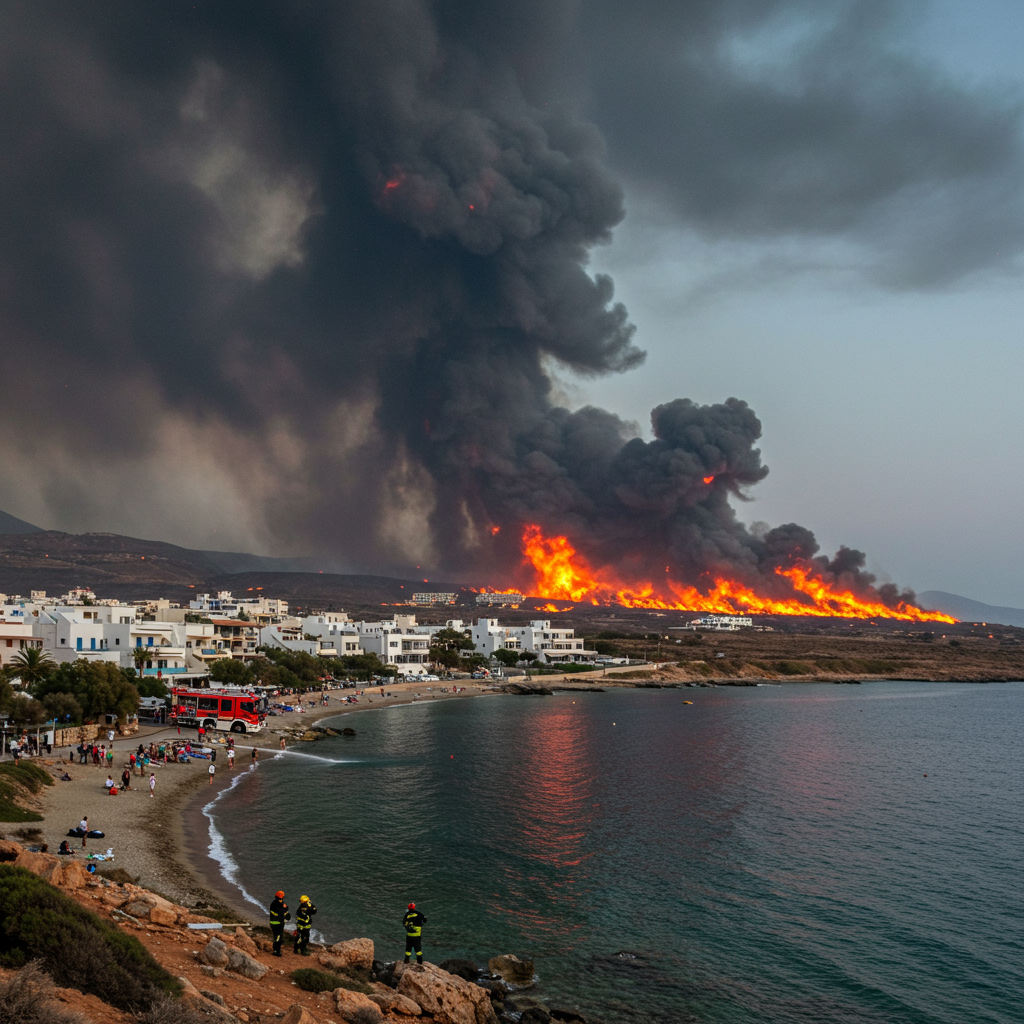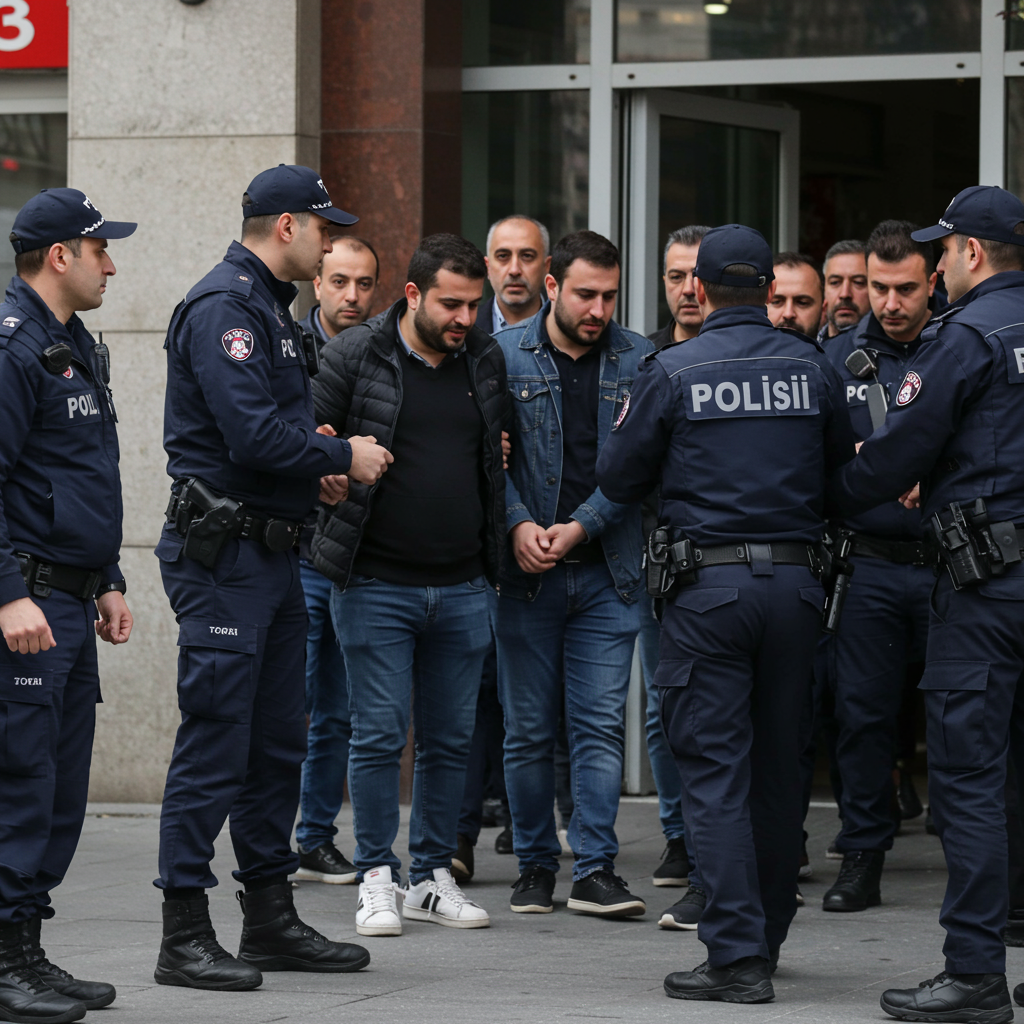An intense wildfire is currently raging across the popular Greek island of crete, forcing widespread evacuations and posing a significant challenge to emergency services. The blaze, centered near the southeastern coastal town of Ierapetra, erupted suddenly on Wednesday afternoon and has rapidly spread, threatening homes, hotels, and vital infrastructure in a major tourist hotspot. Hundreds of firefighters are on the scene, battling difficult conditions as high temperatures and powerful winds fuel the fast-moving flames.
This crisis unfolds as Greece enters the peak period of its fire season, typically the hottest and most challenging months. The situation highlights the increasing severity of extreme weather events across Europe, with several other countries also grappling with destructive wildfires this week.
The Battle Against the Blaze on Crete
The Crete wildfire ignited in rugged, forested hills near Ierapetra on Wednesday afternoon. Driven by exceptionally strong gale-force winds, gusting up to 50 miles per hour (around eight on the Beaufort scale), the fire has spread swiftly southward. Emergency crews report the fire front now extends over 6 kilometers, pushing towards coastal areas and settlements.
More than 200 firefighters were initially deployed, a number quickly increased to over 230 personnel. They are supported by dozens of fire engines, specialized forest commando teams, an Unmanned Aerial Vehicle (UAV) team, and volunteers. At least 10 helicopters have been actively involved in water-dropping operations, though high winds can sometimes ground air support. Reinforcements, including additional teams and equipment, are being brought in from the Greek mainland by sea and air to aid the exhausted local units.
Extreme Conditions Fueling the Inferno
Fighting this particular blaze has proven exceptionally difficult due to the prevailing weather conditions. Unusually high temperatures, several degrees Celsius above average for the season, combined with the powerful winds, are creating a dangerous environment.
Chief Vasilios Vathrakoyannis, the Fire Department’s press spokesperson, stated that these conditions are causing “new outbreaks, making firefighting work very difficult.” The dry, parched ground and dense, flammable vegetation in the affected area, characterized by steep slopes, further complicate containment efforts. Fire crews are focusing their efforts on establishing firebreaks to protect threatened communities, with crews expected to work tirelessly through the night.
Mass Evacuations Impacting Residents and Tourists
As the fire advanced, authorities were compelled to order mass evacuations to ensure public safety. Initial reports indicated around 1,500 people were evacuated, a number that has since risen to approximately 3,000 residents and tourists. Evacuation orders were issued for individuals in several settlements and tourist areas, including Achlia, Ferma, Agia Fotia, Koutsounari, Katharades, and Kakia Skala.
Evacuees were directed to move towards the larger town of Ierapetra. Temporary shelters have been set up to accommodate those displaced. Ierapetra municipality quickly converted an indoor training center facility into a makeshift camp, where many spent the night. Hotels in safer regions of the island have also opened their doors to provide shelter. In some isolated instances, individuals trapped on beaches have reportedly been evacuated by boat, with additional boats on standby for further sea rescues if needed. Authorities have strongly appealed to residents not to attempt to return to their properties during the active fire for any reason.
Health, Safety, and Local Impact
The intense heat and thick smoke generated by the fire have created hazardous conditions on the ground. Reduced visibility due to smoke blanketing the region, even reaching beaches kilometers away, adds another layer of danger. There have been local reports of power cuts in some affected settlements, such as Agia Fotia.
While there have been no widespread health emergencies directly caused by the fire, at least four people have required hospitalization for respiratory problems due to smoke inhalation. Several elderly residents have also received treatment. Hospitals across Crete remain on high alert as a precautionary measure.
Authorities have issued crucial safety advice for anyone in the fire zone, particularly those unable to immediately evacuate. This includes strongly advising against sheltering in cars near the fire, as survival chances are reportedly higher in structures built with non-flammable materials. For those remaining indoors, advice includes:
Firmly closing all doors and windows.
Blocking cracks and gaps with wet clothes to prevent smoke entry.
Removing flammable items like curtains from windows.
Closing all interior doors to slow fire spread within a building.
Gathering in a single room.
Filling bathtubs and basins with water as a reserve.
- Keeping a torch and spare batteries accessible in case of power failure.
- www.independent.co.uk
- www.mirror.co.uk
- www.the-sun.com
- abc17news.com
- keyt.com
Roads near the fire zone have been closed, and both residents and tourists are advised to avoid non-essential travel due to the combined risks of hazardous air quality, heat, ashfall, and restricted visibility.
Crete’s Wildfire Crisis in a Broader Context
This Greece wildfire occurs during what the Ministry for Climate Crisis and Civil Protection calls the “third and most difficult month of the fire season.” Historically, July is the hottest month in Greece, frequently accompanied by strong winds. These environmental factors create conditions highly favorable for wildfires to ignite and spread rapidly, significantly increasing their danger.
Scientists have long identified Greece and other Mediterranean countries as “wildfire hotspots” where blazes are common during the hot, dry summers. However, experts note that these fires have become noticeably more intense and frequent in recent years. This trend is widely linked to human-caused climate change, which drives rising temperatures and prolonged droughts – conditions that prime the landscape for fierce, destructive fires.
The situation on Crete is not isolated. The entire European continent is currently enduring a brutal heatwave, and other countries are also battling significant blazes. In Turkey, extensive wildfires have ripped through provinces like İzmir, Manisa, and Hatay, prompting the evacuation of tens of thousands of people, including over 50,000 in İzmir alone. These fires have caused widespread destruction, damaging nearly 200 homes, and even led to the temporary closure of İzmir’s Adnan Menderes Airport, causing flight delays of up to 20 hours for hundreds of passengers. Tragically, one elderly man died from smoke inhalation during the Turkey fires. Blazes have also been reported this week in France and Spain, where two fatalities have occurred.
While Heraklion and Chania, the two major airports on Crete located in the north, were reported to be operating normally, the crisis underscores the vulnerability of popular tourist destinations to the escalating impacts of the climate crisis during the summer months.
Frequently Asked Questions
Where exactly is the main wildfire burning on Crete and how is it spreading?
The primary wildfire on Crete ignited near the town of Ierapetra, located on the island’s southeast coast. It started in forested hills and has been rapidly spreading southward, driven by strong gale-force winds. The fire front is reported to extend over 6 kilometers as it moves towards the coast and nearby settlements, making it challenging to contain.
What areas have been evacuated due to the Crete wildfire, and where are people finding shelter?
Authorities have ordered mass evacuations from several settlements and tourist areas threatened by the fire. These include Achlia, Ferma, Agia Fotia, Koutsounari, Katharades, and Kakia Skala. Approximately 3,000 residents and tourists have been evacuated. Those displaced are finding temporary shelter primarily at an indoor sports facility in Ierapetra, which has been converted into a makeshift camp, and in hotels located in safer parts of the island.
What are the main dangers associated with the Crete wildfire, and what safety advice are authorities giving?
The primary dangers include the fire itself, intense heat, thick smoke, and falling ash. Smoke inhalation is a significant health risk; several individuals have been hospitalized. Authorities are advising people in affected areas to prioritize evacuation. If unable to evacuate immediately, crucial safety advice includes staying indoors rather than in a car, closing and sealing all doors and windows to prevent smoke entry, removing curtains, closing interior doors, gathering in one room, and preparing water reserves. Non-essential travel near the fire zone is strongly discouraged due to hazardous conditions.
The difficult fight against the Ierapetra fire continues as emergency services battle the out-of-control blaze under punishing environmental conditions. The scale of the evacuations and the resources being deployed highlight the severity of the situation on this popular Greek island. As the peak of the summer fire season progresses and climate change continues to exacerbate extreme weather, the threat of intense wildfires remains a significant concern across Greece and the wider Mediterranean region. The ongoing efforts on Crete serve as a stark reminder of the vulnerability of even well-prepared areas to the forces of nature amplified by a changing climate.



